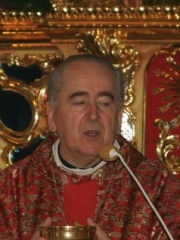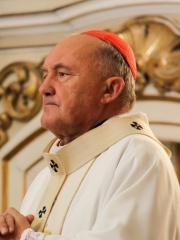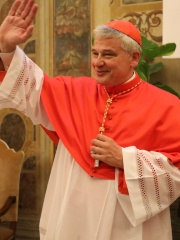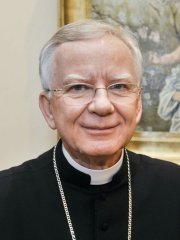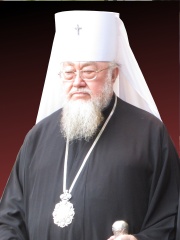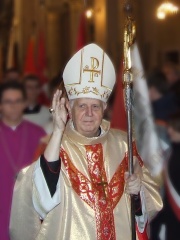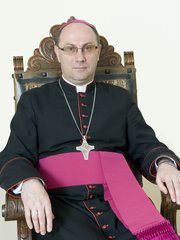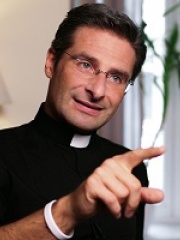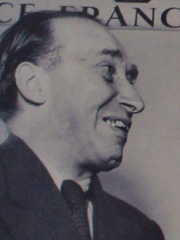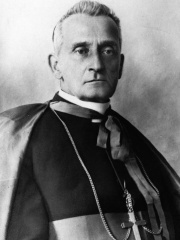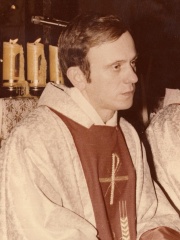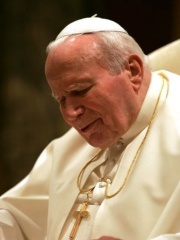
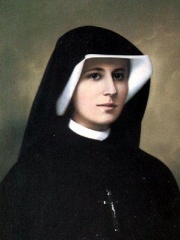
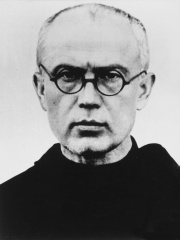
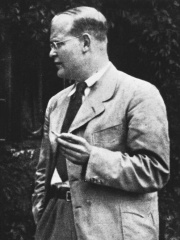
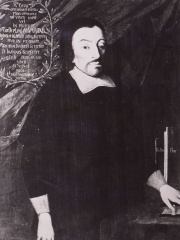
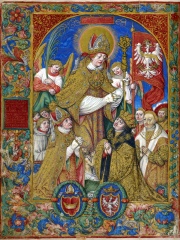
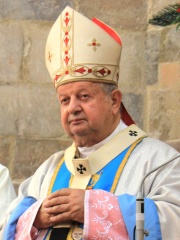
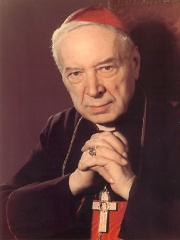
The Most Famous
RELIGIOUS FIGURES from Poland
This page contains a list of the greatest Polish Religious Figures. The pantheon dataset contains 3,187 Religious Figures, 58 of which were born in Poland. This makes Poland the birth place of the 11th most number of Religious Figures behind Egypt, and India.
Top 10
The following people are considered by Pantheon to be the top 10 most legendary Polish Religious Figures of all time. This list of famous Polish Religious Figures is sorted by HPI (Historical Popularity Index), a metric that aggregates information on a biography's online popularity. Visit the rankings page to view the entire list of Polish Religious Figures.

1. Pope John Paul II (1920 - 2005)
With an HPI of 92.56, Pope John Paul II is the most famous Polish Religious Figure. His biography has been translated into 146 different languages on wikipedia.
Pope John Paul II (born Karol Józef Wojtyła; 18 May 1920 – 2 April 2005) was head of the Catholic Church and sovereign of Vatican City from 16 October 1978 until his death in 2005. He was the first non-Italian pope since Adrian VI in the 16th century, as well as the third-longest-serving pope in history, after Pius IX and St. Peter. In his youth, Wojtyła dabbled in stage acting. He graduated with excellent grades from an all-boys high school in Wadowice, Poland, in 1938, soon after which World War II broke out. During the war, to avoid being kidnapped and sent to a German forced labour camp, he signed up for work in harsh conditions in a quarry. Wojtyła eventually took up acting and developed a love for the profession and participated at a local theatre. The linguistically skilled Wojtyła wanted to study Polish at university. Encouraged by a conversation with Adam Stefan Sapieha, he decided to study theology and become a priest. Eventually, Wojtyła rose to the position of Archbishop of Kraków and then a cardinal, both positions held by his mentor. Wojtyła was elected pope on the third day of the October 1978 conclave, becoming one of the youngest popes in history. The conclave was called after the death of John Paul I, who served only 33 days as pope. Wojtyła adopted the name of his predecessor in tribute to him. John Paul II attempted to improve the Catholic Church's relations with Judaism, Islam, and the Eastern Orthodox Church in the spirit of ecumenism, holding atheism as the greatest threat. He maintained the Church's previous positions on such matters as abortion, artificial contraception, the ordination of women, and a celibate clergy, and although he supported the reforms of the Second Vatican Council, he was seen as generally conservative in their interpretation. He put emphasis on family and identity, while questioning consumerism, hedonism and the pursuit of wealth. He was one of the most-travelled world leaders in history, visiting 129 countries during his pontificate. As part of his special emphasis on the universal call to holiness, John Paul II beatified 1,344 people, and canonised 483 saints, more than the combined tally of his predecessors during the preceding five centuries. By the time of his death, he had named most of the College of Cardinals, consecrated or co-consecrated many of the world's bishops, and ordained many priests. John Paul II died on 2 April 2005, and was succeeded by Benedict XVI. John Paul II has been credited with fighting against dictatorships and with helping to end communist rule in his native Poland and the rest of Europe. Under John Paul II, the Catholic Church greatly expanded its influence in Africa and Latin America and retained its influence in Europe and the rest of the world. On 19 December 2009, he was proclaimed venerable by Benedict XVI, and on 1 May 2011 (Divine Mercy Sunday) he was beatified. On 27 April 2014, John Paul II was canonised by Francis, alongside John XXIII. He has been criticised for allegedly, as archbishop under Communist Poland, having been insufficiently harsh in acting against the sexual abuse of children by priests. After his canonisation, he has been referred to by some Catholics as Pope St. John Paul the Great, though that title is not official. Under John Paul II, two of the most important documents of the contemporary Catholic Church were drafted and promulgated: the 1983 Code of Canon Law, which revised and updated the 1917 Code of Canon Law, and the Catechism of the Catholic Church, the first universal catechism to be issued since the Roman Catechism.

2. Faustina Kowalska (1905 - 1938)
With an HPI of 75.76, Faustina Kowalska is the 2nd most famous Polish Religious Figure. Her biography has been translated into 50 different languages.
Maria Faustyna Kowalska of the Blessed Sacrament, OLM (born Helena Kowalska; 25 August 1905 – 5 October 1938) was a Polish Catholic religious sister and mystic. Faustyna, popularly spelled "Faustina", had apparitions of Jesus Christ which inspired the Catholic devotion to the Divine Mercy, therefore she is sometimes called the "secretary" of Divine Mercy. Throughout her life, Kowalska reported having visions of Jesus and conversations with him, which she noted in her diary, later published as The Diary of Saint Maria Faustina Kowalska: Divine Mercy in My Soul. Her biography, submitted to the Congregation for the Causes of Saints, quoted some of the conversations with Jesus regarding the Divine Mercy devotion. At the age of 20 years, she joined a convent in Warsaw. She was later transferred to Płock and then to Vilnius, where she met Father Michał Sopoćko, who was to be her confessor and spiritual director, and who supported her devotion to the Divine Mercy. With this priest's help, Kowalska commissioned an artist to paint the first Divine Mercy image, based on her vision of Jesus. Father Sopoćko celebrated Mass in the presence of this painting on Low Sunday, also known as the Second Sunday of Easter or (as established by Pope John Paul II), Divine Mercy Sunday. The Catholic Church canonized Kowalska as a saint on 30 April 2000. The mystic is classified in the liturgy as a virgin and is venerated within the church as the "Apostle of Divine Mercy". Her tomb is in the Divine Mercy Sanctuary, Kraków, where she spent the end of her life and met confessor Józef Andrasz, who also supported the message of mercy.

3. Maximilian Kolbe (1894 - 1941)
With an HPI of 74.97, Maximilian Kolbe is the 3rd most famous Polish Religious Figure. His biography has been translated into 53 different languages.
Maximilian Maria Kolbe (born Raymund Kolbe; Polish: Maksymilian Maria Kolbe; 8 January 1894 – 14 August 1941) was a Polish Conventual Franciscan friar, priest, missionary, and martyr. He volunteered to die in place of a man named Franciszek Gajowniczek in the German death camp of Auschwitz, located in German-occupied Poland during World War II. He had been active in promoting the veneration of the Immaculate Virgin Mary, founding and supervising the monastery of Niepokalanów near Warsaw, operating an amateur-radio station (SP3RN), and founding or running several other organizations and publications. On 10 October 1982, Pope John Paul II canonized Kolbe and declared him a martyr of charity. The Catholic Church venerates him as the patron saint of amateur radio operators, drug addicts, political prisoners, families, journalists, and prisoners. John Paul II declared him "the patron of our difficult century". His feast day is 14 August, the day of his martyrdom. Due to Kolbe's efforts to promote consecration and entrustment to Mary, he is known as an "apostle of consecration to Mary".

4. Dietrich Bonhoeffer (1906 - 1945)
With an HPI of 74.02, Dietrich Bonhoeffer is the 4th most famous Polish Religious Figure. His biography has been translated into 61 different languages.
Dietrich Bonhoeffer (German: [ˈdiːtʁɪç ˈbɔnhøːfɐ] ; 4 February 1906 – 9 April 1945) was a German Lutheran pastor, neo-orthodox theologian and anti-Nazi dissident who was a key founding member of the Confessing Church. His writings on Christianity's role in the secular world have become widely influential; his 1937 book The Cost of Discipleship is described as a modern classic. Apart from his theological writings, Bonhoeffer was known for his staunch resistance to the Nazi dictatorship, including vocal opposition to Nazi euthanasia program and genocidal persecution of Jews. He was arrested in April 1943 by the Gestapo and imprisoned at Tegel Prison for a year and a half. Later, he was transferred to Flossenbürg concentration camp. Bonhoeffer was accused of being associated with the 20 July plot to assassinate Hitler and was tried along with other accused plotters, including former members of the Abwehr (the German Military Intelligence Office). He was hanged on 9 April 1945 during the collapse of the Nazi regime.
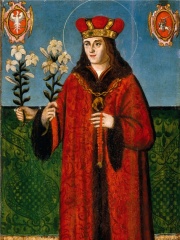
5. Saint Casimir (1458 - 1484)
With an HPI of 72.02, Saint Casimir is the 5th most famous Polish Religious Figure. His biography has been translated into 39 different languages.
Casimir Jagiellon (; Latin: Casimirus; Lithuanian: Kazimieras; Polish: Kazimierz; 3 October 1458 – 4 March 1484) was a prince of the Kingdom of Poland and of the Grand Duchy of Lithuania. The second son of King Casimir IV Jagiellon, he was tutored by Johannes Longinus, a Polish chronicler, diplomat, and priest. After his elder brother Vladislaus was elected as King of Bohemia in 1471, Casimir became the heir apparent. At the age of 13, Casimir participated in the failed military campaign to install him as King of Hungary. He became known for his piety, devotion to God, and generosity towards the sick and poor. He became ill (most likely with tuberculosis) and died at the age of 25. He was buried in Vilnius Cathedral. His canonization was initiated by his brother King Sigismund I the Old in 1514 and the tradition holds that he was canonized in 1521. Saint Casimir the Prince is the patron saint of Poland, Lithuania and Lithuanian youth and the only saint with this name. Veneration of Casimir saw a resurgence in the 17th century when his feast day was confirmed by the pope in 1602 and the dedicated Chapel of Saint Casimir was completed in 1636. Casimir became a patron saint of Lithuania and Lithuanian youth. In Vilnius, his feast day is marked annually with Kaziuko mugė (a trade fair) held on the Sunday nearest to 4 March, the anniversary of his death. There are more than 50 churches named after Casimir in Lithuania and Poland, including Church of St. Casimir, Vilnius and St. Kazimierz Church, Warsaw, and more than 50 churches in Lithuanian and Polish diaspora communities in America. Women's congregation Sisters of Saint Casimir was established in 1908 and remains active in the United States.

6. Angelus Silesius (1624 - 1677)
With an HPI of 71.03, Angelus Silesius is the 6th most famous Polish Religious Figure. His biography has been translated into 32 different languages.
Angelus Silesius, OFM (c. 1624 – 9 July 1677), born Johann Scheffler, was a German Catholic priest, physician, mystic and religious poet. Born and raised a Lutheran, he began to read the works of medieval mystics while studying in the Netherlands and became acquainted with the works of the German mystic Jacob Böhme through Böhme's friend Abraham von Franckenberg. Silesius's display of his mystic beliefs caused tension with Lutheran authorities and led to his eventual conversion to Catholicism in 1653, wherein he adopted the name Angelus (Latin for "angel" or "heavenly messenger") and the epithet Silesius ("Silesian"). He entered the Franciscans and was ordained a priest in 1661. Ten years later, in 1671, he retired to a Jesuit house where he remained for the rest of his life. An enthusiastic convert and priest, Silesius worked to convince German Protestants in Silesia to return to the Catholic Church. He composed 55 tracts and pamphlets condemning Protestantism, several of which were published in two folio volumes entitled Ecclesiologia (i.e., Ecclesiology). However, he is now remembered chiefly for his mystical poetry, and in particular for two poetical works, both published in 1657: Heilige Seelen-Lust (The Soul's Holy Desires), a collection of more than 200 religious hymn texts that have since been used by both Catholics and Protestants; and Cherubinischer Wandersmann ("The Cherubic Pilgrim"), a collection of 1,676 short poems, mostly in Alexandrine couplets. His poetry explores contemporary themes of the greatness of God, mystic interpretations of the Trinity, quietist practices, and pantheism within an orthodox Catholic context.

7. Stanislaus of Szczepanów (1030 - 1079)
With an HPI of 69.24, Stanislaus of Szczepanów is the 7th most famous Polish Religious Figure. His biography has been translated into 29 different languages.
Stanislaus of Szczepanów (Polish: Stanisław ze Szczepanowa; 26 July 1030 – 11 April 1079) was a Polish Catholic prelate who served as Bishop of Kraków and was martyred by the Polish King Bolesław II the Bold. He is the patron saint of Poland. Stanislaus is venerated in the Catholic Church as Stanislaus the Martyr (as distinct from the 16th-century Jesuit, Stanislaus Kostka).

8. Stanisław Dziwisz (b. 1939)
With an HPI of 68.60, Stanisław Dziwisz is the 8th most famous Polish Religious Figure. His biography has been translated into 28 different languages.
Stanisław Jan Dziwisz (Polish pronunciation: [staˈɲiswav ˈdʑiviʂ]; born 27 April 1939) is a Polish Catholic prelate who served as Metropolitan Archbishop of Kraków from 2005 to 2016. He was created a cardinal in 2006. He was a long-time and influential aide to Pope John Paul II, a friend of Pope Benedict XVI, and an ardent supporter of John Paul II's beatification.

9. Stefan Wyszyński (1901 - 1981)
With an HPI of 68.15, Stefan Wyszyński is the 9th most famous Polish Religious Figure. His biography has been translated into 40 different languages.
Stefan Wyszyński (Polish pronunciation: [ˈstɛfan vɨˈʂɨj̃skʲi]; 3 August 1901 – 28 May 1981) was a Polish Roman Catholic prelate who served as Archbishop of Warsaw and Archbishop of Gniezno from 1948 to 1981. He previously served as Bishop of Lublin from 1946 to 1948. He was created a cardinal on 12 January 1953 by Pope Pius XII. As Archbishop of Gniezno, Wyszyński possessed the title, "Primate of Poland". The case for Wyszyński's canonization was opened in 1989. He is well known for his stands against both Nazism and Communism, and because of his connections to Pope John Paul II; he played a key role in urging Wojtyła to accept being elected as pope. Pope Francis beatified Wyszyński on 12 September 2021. To many, Wyszyński was the unquestionable spiritual leader of the Polish nation, credited with the survival of Polish Christianity in the face of repression and persecution during the 1945–1989 Communist regime. He himself was imprisoned for three years, and is considered by many to be one of Poland's national heroes.
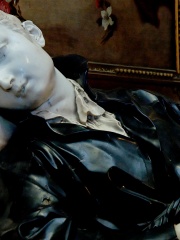
10. Stanislaus Kostka (1550 - 1568)
With an HPI of 68.12, Stanislaus Kostka is the 10th most famous Polish Religious Figure. His biography has been translated into 26 different languages.
Stanisław Kostka, S.J. (28 October 1550 – 15 August 1568) was a Polish novice in the Society of Jesus. He was born at Rostkowo, Przasnysz County, Poland, on 28 October 1550, and died in Rome during the night of 14–15 August 1568. He is said to have foretold his death a few days before it occurred. He was canonized in 1726.
People
Pantheon has 58 people classified as Polish religious figures born between 1030 and 1972. Of these 58, 10 (17.24%) of them are still alive today. The most famous living Polish religious figures include Stanisław Dziwisz, Stanisław Ryłko, and Kazimierz Nycz. The most famous deceased Polish religious figures include Pope John Paul II, Faustina Kowalska, and Maximilian Kolbe. As of April 2024, 1 new Polish religious figures have been added to Pantheon including Wojciech Polak.
Living Polish Religious Figures
Go to all RankingsStanisław Dziwisz
1939 - Present
HPI: 68.60
Stanisław Ryłko
1945 - Present
HPI: 66.52
Kazimierz Nycz
1950 - Present
HPI: 60.93
Konrad Krajewski
1963 - Present
HPI: 58.42
Anna Wierzbicka
1938 - Present
HPI: 58.24
Marek Jędraszewski
1949 - Present
HPI: 57.03
Sawa
1938 - Present
HPI: 56.33
Stanisław Wielgus
1939 - Present
HPI: 55.87
Wojciech Polak
1964 - Present
HPI: 46.96
Krzysztof Charamsa
1972 - Present
HPI: 46.83
Deceased Polish Religious Figures
Go to all RankingsPope John Paul II
1920 - 2005
HPI: 92.56
Faustina Kowalska
1905 - 1938
HPI: 75.76
Maximilian Kolbe
1894 - 1941
HPI: 74.97
Dietrich Bonhoeffer
1906 - 1945
HPI: 74.02
Saint Casimir
1458 - 1484
HPI: 72.02
Angelus Silesius
1624 - 1677
HPI: 71.03
Stanislaus of Szczepanów
1030 - 1079
HPI: 69.24
Stefan Wyszyński
1901 - 1981
HPI: 68.15
Stanislaus Kostka
1550 - 1568
HPI: 68.12
Itzhak Stern
1901 - 1969
HPI: 67.14
Adam Stefan Sapieha
1867 - 1951
HPI: 66.38
Jerzy Popiełuszko
1947 - 1984
HPI: 65.87
Newly Added Polish Religious Figures (2025)
Go to all RankingsOverlapping Lives
Which Religious Figures were alive at the same time? This visualization shows the lifespans of the 25 most globally memorable Religious Figures since 1700.

